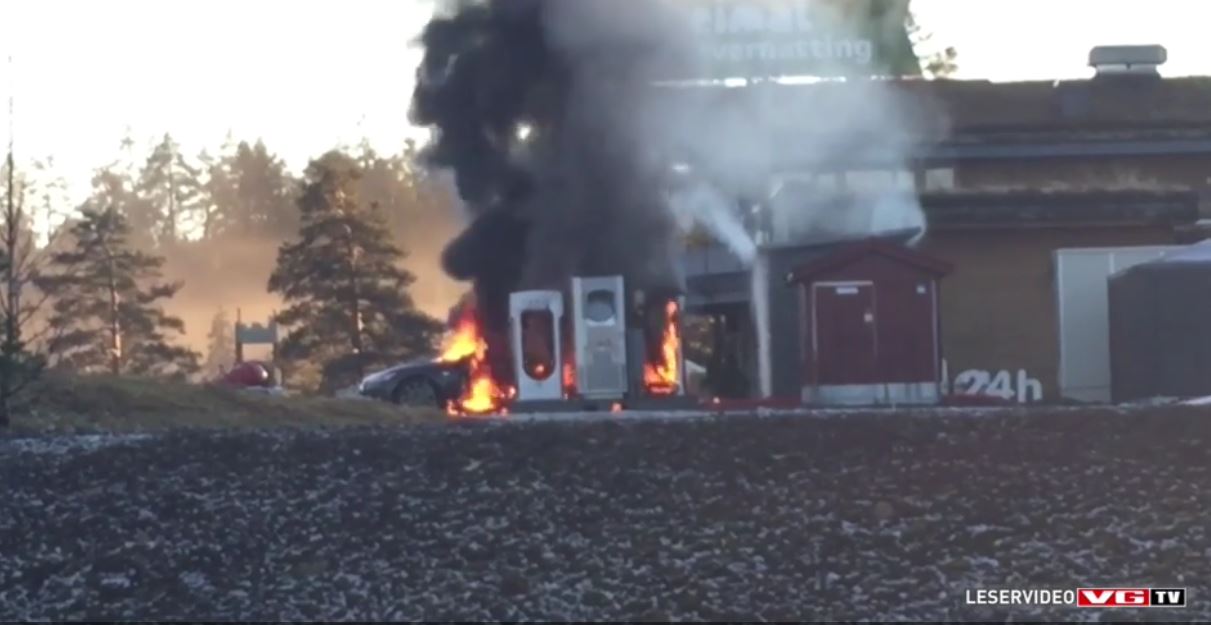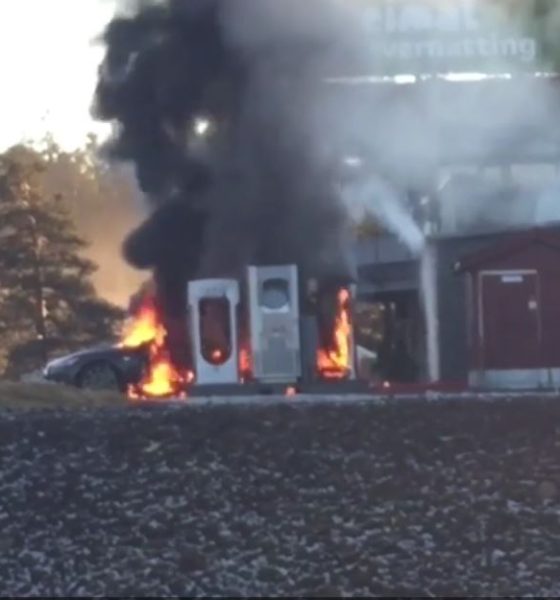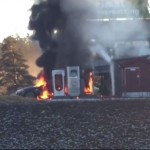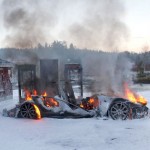

News
Tesla Identifies Cause for Model S Fire in Norway
After an exhaustive investigation, Tesla Motors has determined that the fire in a Model S in Norway last January was caused by a short circuit inside the electrical distribution box. A software upgrade is planned shortly.
After an exhaustive inquiry, Tesla Motors has determined the cause for the fire that engulfed a Tesla Model S while it was charging at a Supercharger station in Norway. The culprit – a short circuit in the electrical distribution box inside the vehicle according to Norwegian news site VG.
Tesla Communication Manager in Norway, Even Sandvold Roland, tells VG via e-mail, “In January, it was an isolated incident where a Model S caught fire while it used a Supercharger. The cause was a short circuit in the distribution box in the car. Superchargers were turned off immediately when the short circuit was discovered. No one was injured in the fire. Our investigation confirmed that this was an isolated incident, but due to the damage to the car, we could not definitely identify the exact cause of the short circuit.”.
Jan 1, 2016 – Tesla Model S burns to the ground while fast-charging at the Sundebru Supercharger in Gjerstad, Norway. [Source: VG]
Tesla pointed out that its vehicles have used Tesla Supercharger stations safely more than 2.5 million times. In addition, more than 35 million charging sessions have been completed safely and successfully using either home or destination chargers. Nevertheless, the company says it will update the software package in the Model S to provide extra security during charging. It tells VG the update will include a diagnostic solution to prevent charging if a potential short circuit is detected.
The cause of the fire could not be pinpointed further due to the extensive damage to the car. Norwegian firefighters, concerned for their own safety during their first encounter with a burning electric car, allowed the fire to burn itself out while protecting surrounding buildings with fire retardant foam.
The Norwegian Directorate for Civil Protection and Emergency Planning (DSB) was involved in the investigation of the fire. It had several meetings with Tesla representatives and is convinced this was an isolated incident. There is no reason to over-dramatize the event, they concluded.
DSB chief engineer Jostein Ween Dig told VG, “We are confident that this is a special event. A car fire is often spectacular, but there is no reason to believe that electric cars burn more often than other cars. Statistics actually indicate that incidence of fires is lower for electric cars, he said.
Actually, the fire was a “kinder” event than a fossil fuel fire, Dig said. “The owner had time to run back, unplug the charger connector and remove his possessions from the car. It took several minutes before the car was ablaze. Normally an electric vehicle fire is not as explosive as it can be in a petrol car. The flames you see in the picture and video were mostly from plastic in the interior that caught fire.” He emphasized that the battery did not explode.
Norwegian officials seem satisfied that Tesla automobiles and Supercharger stations pose no unusual risks of fire. The Supercharger location is now back in full operation and doing business as usual.
Special thanks to Leif Hansen in Norway for alerting us to the VB news story.
Photo Credit: VB News

Elon Musk
Tesla’s Elon Musk: 10 billion miles needed for safe Unsupervised FSD
As per the CEO, roughly 10 billion miles of training data are required due to reality’s “super long tail of complexity.”

Tesla CEO Elon Musk has provided an updated estimate for the training data needed to achieve truly safe unsupervised Full Self-Driving (FSD).
As per the CEO, roughly 10 billion miles of training data are required due to reality’s “super long tail of complexity.”
10 billion miles of training data
Musk comment came as a reply to Apple and Rivian alum Paul Beisel, who posted an analysis on X about the gap between tech demonstrations and real-world products. In his post, Beisel highlighted Tesla’s data-driven lead in autonomy, and he also argued that it would not be easy for rivals to become a legitimate competitor to FSD quickly.
“The notion that someone can ‘catch up’ to this problem primarily through simulation and limited on-road exposure strikes me as deeply naive. This is not a demo problem. It is a scale, data, and iteration problem— and Tesla is already far, far down that road while others are just getting started,” Beisel wrote.
Musk responded to Beisel’s post, stating that “Roughly 10 billion miles of training data is needed to achieve safe unsupervised self-driving. Reality has a super long tail of complexity.” This is quite interesting considering that in his Master Plan Part Deux, Elon Musk estimated that worldwide regulatory approval for autonomous driving would require around 6 billion miles.
FSD’s total training miles
As 2025 came to a close, Tesla community members observed that FSD was already nearing 7 billion miles driven, with over 2.5 billion miles being from inner city roads. The 7-billion-mile mark was passed just a few days later. This suggests that Tesla is likely the company today with the most training data for its autonomous driving program.
The difficulties of achieving autonomy were referenced by Elon Musk recently, when he commented on Nvidia’s Alpamayo program. As per Musk, “they will find that it’s easy to get to 99% and then super hard to solve the long tail of the distribution.” These sentiments were echoed by Tesla VP for AI software Ashok Elluswamy, who also noted on X that “the long tail is sooo long, that most people can’t grasp it.”
News
Tesla earns top honors at MotorTrend’s SDV Innovator Awards
MotorTrend’s SDV Awards were presented during CES 2026 in Las Vegas.

Tesla emerged as one of the most recognized automakers at MotorTrend’s 2026 Software-Defined Vehicle (SDV) Innovator Awards.
As could be seen in a press release from the publication, two key Tesla employees were honored for their work on AI, autonomy, and vehicle software. MotorTrend’s SDV Awards were presented during CES 2026 in Las Vegas.
Tesla leaders and engineers recognized
The fourth annual SDV Innovator Awards celebrate pioneers and experts who are pushing the automotive industry deeper into software-driven development. Among the most notable honorees for this year was Ashok Elluswamy, Tesla’s Vice President of AI Software, who received a Pioneer Award for his role in advancing artificial intelligence and autonomy across the company’s vehicle lineup.
Tesla also secured recognition in the Expert category, with Lawson Fulton, a staff Autopilot machine learning engineer, honored for his contributions to Tesla’s driver-assistance and autonomous systems.
Tesla’s software-first strategy
While automakers like General Motors, Ford, and Rivian also received recognition, Tesla’s multiple awards stood out given the company’s outsized role in popularizing software-defined vehicles over the past decade. From frequent OTA updates to its data-driven approach to autonomy, Tesla has consistently treated vehicles as evolving software platforms rather than static products.
This has made Tesla’s vehicles very unique in their respective sectors, as they are arguably the only cars that objectively get better over time. This is especially true for vehicles that are loaded with the company’s Full Self-Driving system, which are getting progressively more intelligent and autonomous over time. The majority of Tesla’s updates to its vehicles are free as well, which is very much appreciated by customers worldwide.
Elon Musk
Judge clears path for Elon Musk’s OpenAI lawsuit to go before a jury
The decision maintains Musk’s claims that OpenAI’s shift toward a for-profit structure violated early assurances made to him as a co-founder.

A U.S. judge has ruled that Elon Musk’s lawsuit accusing OpenAI of abandoning its founding nonprofit mission can proceed to a jury trial.
The decision maintains Musk’s claims that OpenAI’s shift toward a for-profit structure violated early assurances made to him as a co-founder. These claims are directly opposed by OpenAI.
Judge says disputed facts warrant a trial
At a hearing in Oakland, U.S. District Judge Yvonne Gonzalez Rogers stated that there was “plenty of evidence” suggesting that OpenAI leaders had promised that the organization’s original nonprofit structure would be maintained. She ruled that those disputed facts should be evaluated by a jury at a trial in March rather than decided by the court at this stage, as noted in a Reuters report.
Musk helped co-found OpenAI in 2015 but left the organization in 2018. In his lawsuit, he argued that he contributed roughly $38 million, or about 60% of OpenAI’s early funding, based on assurances that the company would remain a nonprofit dedicated to the public benefit. He is seeking unspecified monetary damages tied to what he describes as “ill-gotten gains.”
OpenAI, however, has repeatedly rejected Musk’s allegations. The company has stated that Musk’s claims were baseless and part of a pattern of harassment.
Rivalries and Microsoft ties
The case unfolds against the backdrop of intensifying competition in generative artificial intelligence. Musk now runs xAI, whose Grok chatbot competes directly with OpenAI’s flagship ChatGPT. OpenAI has argued that Musk is a frustrated commercial rival who is simply attempting to slow down a market leader.
The lawsuit also names Microsoft as a defendant, citing its multibillion-dollar partnerships with OpenAI. Microsoft has urged the court to dismiss the claims against it, arguing there is no evidence it aided or abetted any alleged misconduct. Lawyers for OpenAI have also pushed for the case to be thrown out, claiming that Musk failed to show sufficient factual basis for claims such as fraud and breach of contract.
Judge Gonzalez Rogers, however, declined to end the case at this stage, noting that a jury would also need to consider whether Musk filed the lawsuit within the applicable statute of limitations. Still, the dispute between Elon Musk and OpenAI is now headed for a high-profile jury trial in the coming months.











